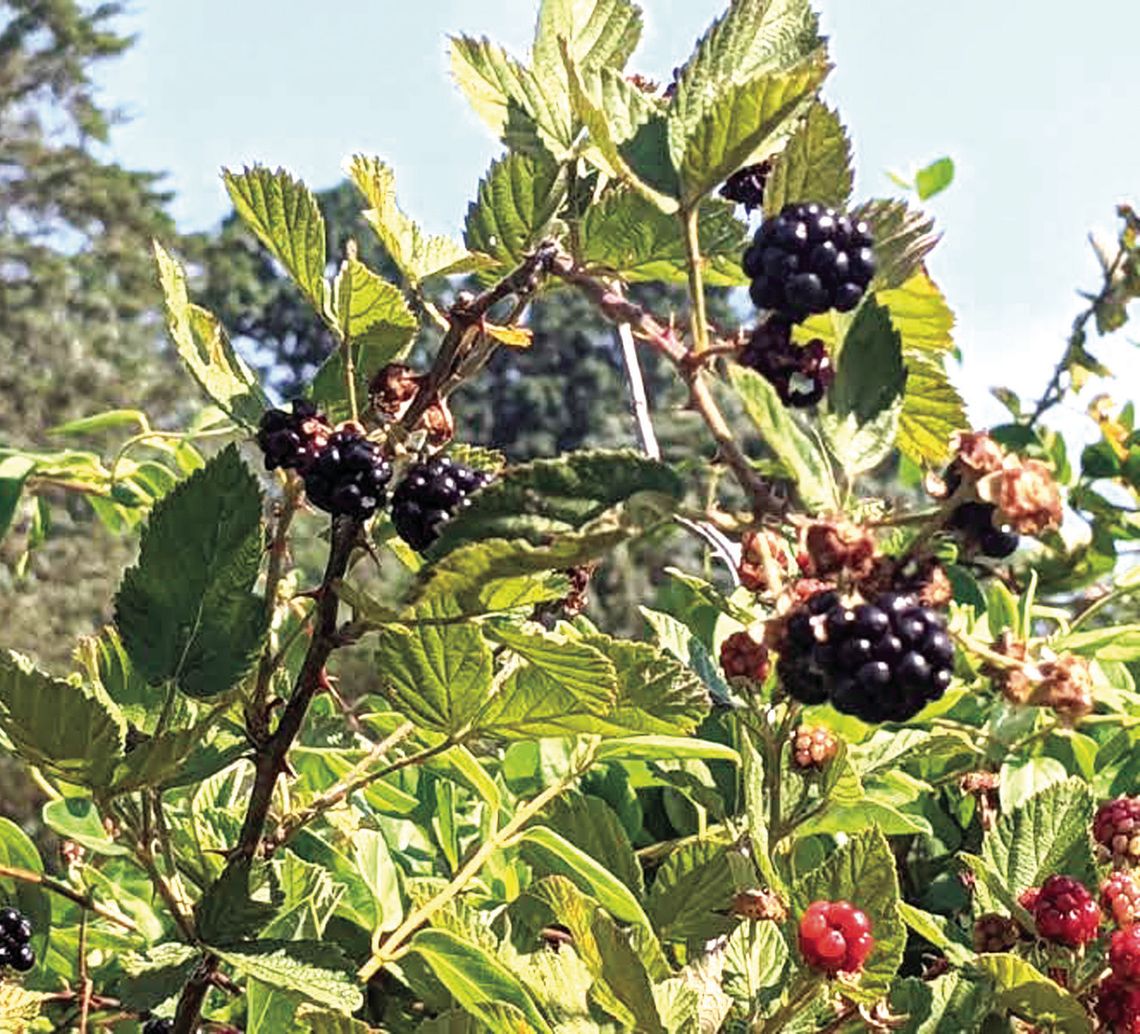Editorial
Editor’s note: With our heads spinning from all of the national political news of the past two weeks, we thought we’d give you a respite from that in our editorial space. Kit Huffman, one of our former reporters and a lover of nature, has written the following piece on picking blackberries. She said she dedicates it to her brother-in-law, Bill Mares, who “encouraged her to keep writing.”
There’s something inconsequential, even childlike, about picking wild blackberries.
For one thing, the picker had nothing to do with the growing, such as planting, feeding or, most likely, even pruning the plants. The canes just appeared on their own, biennials with fruit in the second year, emerging from the perennial plant below. This does mean that the first-year, nonbearing canes present a thorny barrier to the second-year treasure, but what are a few scratches and pricked fingers compared to what is, after all, one of the most antioxidant- rich, not to mention purely delicious, treats of the season?
Second, one doesn’t really expect to gather very many ripe blackberries in one picking, unless one is unusually dedicated. No, it usually takes a couple of pickings, at least, to achieve the two cups or more called for by most recipes for baked blackberry crisp or the intriguingly named blackberry buckle. (The latter is named for the dessert’s habit of “buckling” under the weight of cooked berries mingled with crumb topping.)
And third, picking berries whisks you away from the real world and its responsibilities, at least while you’re picking. What’s left is a finely-tuned awareness, the way children experience their surroundings and adults too often forget to.
“Ping” go the first ripe berries as they hit the tin cup appropriately labeled with “Blackberries fresh-picked” on the side. As more berries follow, the “ping” disappears, deadened by the fruit below. N ow o ther s ounds emerge close by, like the mockingbird, heedless of copyright as it mimics other birdsongs, and a Carolina wren shrilling that a “tea kettle, tea kettle” is about to boil o ver. A b eetle b uzzes out of the bush, heralding the swarms that will soon arrive to cover any over-ripe fruit with their gleaming, but repulsive, brown carapaces.
The cup fills, and my mind roves to a child who picked along this same straggling fenceline 20 years ago. My niece, visiting from the U.K., was determined to bring a crop to the farmers market, then being held at the Virginia Horse Center. She picked several quarts – much more than I aspire to now - and packed the washed fruit into small transparent plastic cups to display on a table with a flowered c loth. H er p roud harvest is preserved in my memory, as sweet as any blackberry jam or buckle.
Memories continue to gather as the hunt goes on and the hound pants in the shade, her leash secured on a bare cedar snag.
There were those mid-August mornings – a later season 500 miles north and five decades ago – where the blackberry bushes stretched endlessly across the rockstrewn hillside of Vermont’s Northeast Kingdom, old pastures offering a new harvest of sunshine. Those berries soon were alchemized into purple-staining jam, served on whole-grain bread at my sister’s hilltop wedding. A bagpipe had piped us up the hill, with our wildflower bouquets and inextinguishable youth, and I can hear the music yet.
The allure of blackberries is not to be denied, sometimes leading to strange disappearances. A farmer I knew was “lost” for a day while picking blackberries with his friends in the countryside. He returned before dark, his pail full of fruit but a bucketful of chores waiting.
I understand how it happens. There’s just that moment when you spot a shiny black globe high up among its red, unripe neighbors and then reach for it, daring the thorns to scratch and, even when they do, not letting go of the prize – that success allows no intrusion. And here is another berry lower down, and another and another. All duties now must knock in vain, like a photo with the subject in focus and the background set to “blur.”
For most of the year, of course, blackberry bushes are nothing but an invasive nuisance, popping up in the grass when the lawn is left unmown and towering over the yard fence. Fall, winter and early spring see warfare against the plant, which must be cut back and civilized, along with its equally aggressive allies. Who living in the country hasn’t struggled with honeysuckle wrapped around a barbarously thorny cane, with trumpet vine and poison ivy probably thrown in for good measure? These enemies must be vanquished and dragged triumphantly, but gingerly, with heavy gloves and a ground cloth, to the brush pile behind the shed, for a decent open-air burial.
But come late spring one spots the first small white flowers on their secondyear canes, if not inside the yard then close by, along the driveway or on an old farm fence. And in July all is forgiven, the enemy now a prized guest.
Now is the time to set off with the dog, the tin cup and a straw hat against the sun, ready to claim a reward which, free-growing and unworked for, is all the sweeter for that.
.jpg)



